THE INVESTMENT
TOWARDS the end of 1987 and in 1988, the Macau Pension Fund bought a set of works of art by Japanese artists of the eighteenth and nineteenth centuries, including two I collections by Katsushika Hokusai and Ando Hiroshije on "The thirty-six views of Mount Fuji", in addition to two separate engravings by Utamaro and Harunobu.
This move, based on the idea of diversifying investments is quite common, given the fact that there are no short term liabilities and the conditions prevailing after the crash by the end of 1987 which made markets very unstable. In view of that a more conservative approach had to be considered as opposed to the previous investment markets in which the Fund was involved.
The whole transaction involved only a small percentage of resources and the investment came in line with the privatisation of British Railways, except for Hiroshije's engravings.
Focusing on the most valuable set consisting of Hokusai's engravings (1760-1849) and additional engravings totalling 46, most of 1988 was spent looking for the missing 5 and restoring those engravings which were folded. Supposedly after being bought by British Railways the engravings were untouchable but unfortunately they had spots, were wrinkled and their edges were glued.
The restoration work which included 4 engravings bought in 1988, was carried out in the United States of America by one of the world's best experts in the field, the late Mrs. Keiko Mizushima Keyes, making use of some rather tedious techniques such as special rubbers, micro-spatulas and steam projection.
The purchase of these works of art was conducted mainly on investment grounds but the Fund saw it as a cultural move as well. The more exposure these works have, the more they will increase in value.
In line with this the Fund approached the Calouste Gulbenkian Foundation in 1989 to find out whether they would be interested in showing the works of art and at the same time storing and protecting them.
However, as a party showed interest in buying the works, discussions with the Foundation were suspended. Again this move did not come to an end because the Fund thought that the whole collection would be worth much more if the missing work could be bought.
It is worth mentioning that had we sold the set of Hokusai's engravings, a net annual profit of approximately 27% would have been made taking into consideration dates and price of purchase of the initial set and the additional four engravings, and costs incurred in restoring and insuring; this percentage was calculated against the average earnings on fixed deposits for the same amount of money and appreciation arising from the remaining financial investments.
Still in 1989, different copies of the missing engraving were found but were all turned down due to their poor quality and dimensions. Towards the end of 1989 the process was completed successfully.
The Government's option to pay pensions and other contributions to those people who do not work forced the Fund to move from short-term projects in terms of immediate liquidity requirements.
However, this option calls for special care to be taken and therefore the Fund tends to resort to experts and that is what it did in the case of the works of art.
It is unlikely that the favourable conditions prevailing in 1989 will be available again mainly because investors are acting more and more in Japan and Taiwan. Nevertheless, given the outstanding quality of the Fund's engravings which are considered valuable to any museum (corresponding to the first twenty reproductions from each wooden block) selling them in very advantageous conditions remains unchanged.
THE COLLECTION
"THE thirty-six views of Fuji" (in Japanese "Fugaku Sanju Rok'kei") consist of 46 engravings grouped into two series of 36 and 10 pieces respectively, and depict different "front" (Omote Fuji) and "back" (Ura Fuji) views of Mount Fuji.
At an auction held in London on 8th December, 1987, the Fund bought all engravings composing the first series and five of the second series. The remaining five were bought in 1988 (4) and 1989 (1).
These series are considered as the most representative work done by Hokasai using the engraving technique on wooden blocks; it is thought that the first series was published between 1831 and 1834, the period in which Mount Fuji become very popular as a cult object of Edo inhabitants.
It is likely that the success scored by the first series based the production of the additional ten engravings.
We are able to determine a time gap in which the first series was produced but sorting them in chronological order is somewhat difficult.
To achieve this, various attempts were made by grouping them according to the different signatures used by Hokusai or even according to the different style of writing used in the said signatures, the ideogram used or grouping the regions from which Mount Fuji is depicted. However, none is accurate enough to prevail over the others.
The very same issue was raised during the purchase and restoration processes, namely when we compared the information contained in Sotheby's catalogues which in fact based the auction, those released by the expert who took part in the purchase and comments made by the Japanese lady who restored the engravings. According to Mrs. Keyes, engravings were produced in an order different to that of the "separation" based on the mounting conditions at the time of the purchase.
To this end, we ordered engravings in accordance with the most commonly accepted order as suggested by M. de Concourt and stated in his work on Hokasai.
On the other hand, Japanese names were taken from Sotheby's catalogue while descriptions were based on different texts and our own investigation.
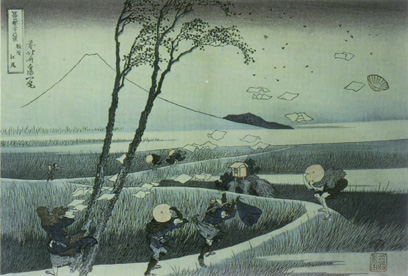 1 "Sunshu Ejiri"-Fuji depicted from Ejiri, Suruga province, across a rice field on a windy day and travellers fighting against the storm.
1 "Sunshu Ejiri"-Fuji depicted from Ejiri, Suruga province, across a rice field on a windy day and travellers fighting against the storm.
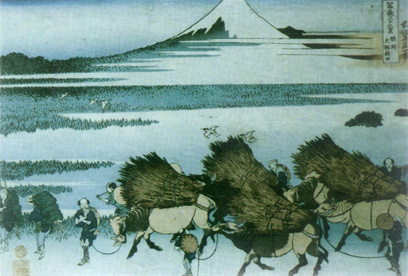 2 "Sunshu Ono Shinden"-Fuji depicted from Ono Shiuden province over the water and its foot hidden by mist; depicted as well are some farmers taking care of cattle (bought in 1989).
2 "Sunshu Ono Shinden"-Fuji depicted from Ono Shiuden province over the water and its foot hidden by mist; depicted as well are some farmers taking care of cattle (bought in 1989).
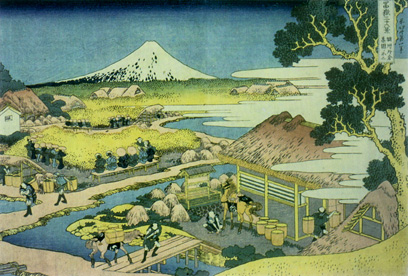 3 "Sunshu Katakura Chaen no Fuji"-Fuji seen from Katakura tea fields where women collect tea while coolies carry it to the shops.
3 "Sunshu Katakura Chaen no Fuji"-Fuji seen from Katakura tea fields where women collect tea while coolies carry it to the shops.
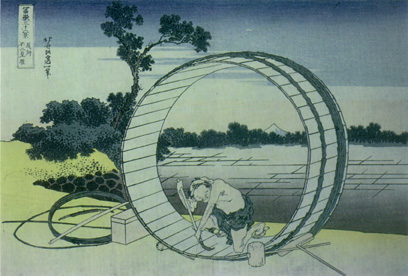 4 "Bishu Fujimigahara"-View of Mount Fuji across a large wooden construction caulked by a worker. Fujimigahara, Owari Province.
4 "Bishu Fujimigahara"-View of Mount Fuji across a large wooden construction caulked by a worker. Fujimigahara, Owari Province.
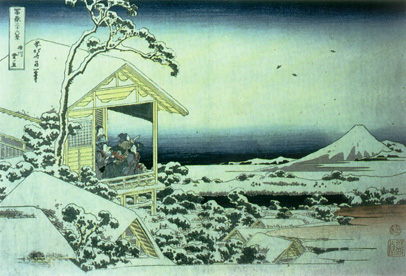 5 "Koishitawa Yuki no ashita"-Fuji seen from Ko-ishi-kawa. Yedo Province, depicting a tea house from where patrons watch a snow covered landscape in winter.
5 "Koishitawa Yuki no ashita"-Fuji seen from Ko-ishi-kawa. Yedo Province, depicting a tea house from where patrons watch a snow covered landscape in winter.
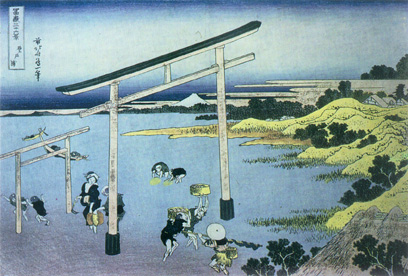 6 "noboto-ura"-View taken from Todo beach where fishermen collect shells. Mount Fuji is framed by one of two traditional arches.
6 "noboto-ura"-View taken from Todo beach where fishermen collect shells. Mount Fuji is framed by one of two traditional arches.
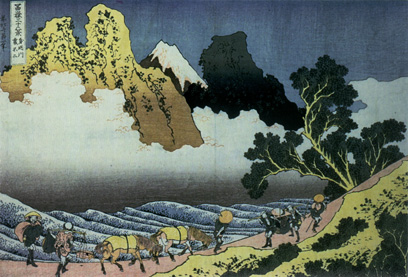 7 "Monobugawa ura Fuji"-Mount Fuji seen from the banks of river Minobu depicting horses and servants.
7 "Monobugawa ura Fuji"-Mount Fuji seen from the banks of river Minobu depicting horses and servants.
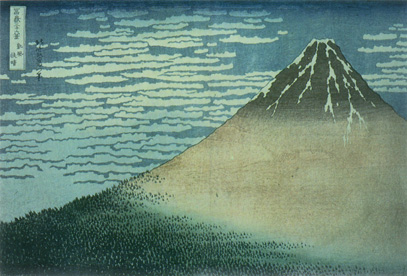
8 "Gaifu Kaisei"-Mount Fuji on a fine day emphasising the red colour of its peak together with some snow against a background of blue sky covered with a few nimbus clouds.
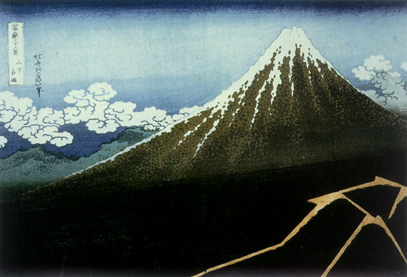
9 "Sanka haku-u"-It depicts a storm on Mount Fuji's slopes with lightning around its foot.
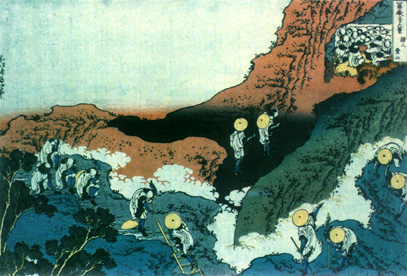
10 "Shojin Tozan"-Engraving depicting a group of pilgrims climbing the mountain while others pray in a grotto (bought 1988).
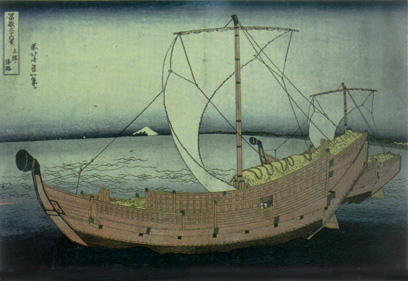
11 "Kasusa no Kairo"-Perspective taken from Narumi, Kasusa Province depicting two junks (sengoku-bune) with unfurled sails, one of which takes-up most of the engraving.
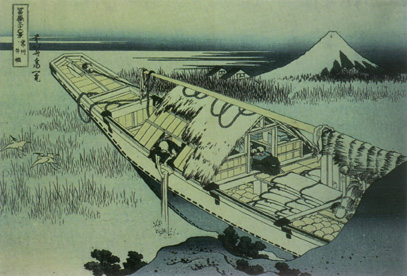
12 "Joshu Ushibori"-Mount Fuji depicted from Ushibori, Hitachi Province, from a junk moored against a sand-bank.
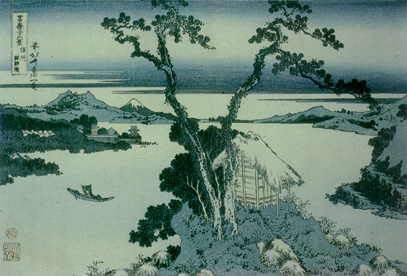
13 "Shinshu Suwa-ko"-Perspective from Suwa lake, Shinamo Province, depicting in the centre a rocky headland with a hut and two pine trees.
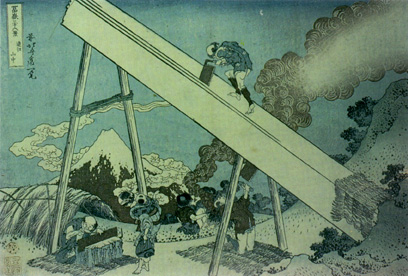
14 "Totomi Sanchu"-Mount Fuji seen from Totomi mountain, framed by a tree trunk supporting device which is cut by a woodcutter.
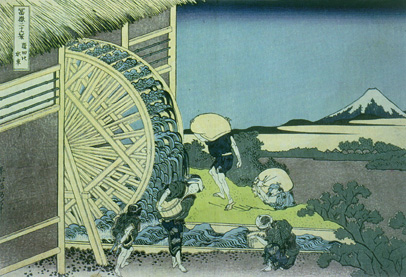
15 "Onden no Suisha"-View from a watermill in Onden town.
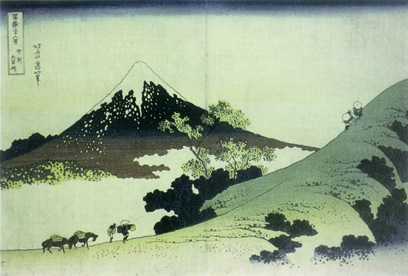
16 "Koshu Inume-toge"-Fuji seen from Inume Gorge, Kai Province, depicting a group of travellers and packhorses climbing a hill.
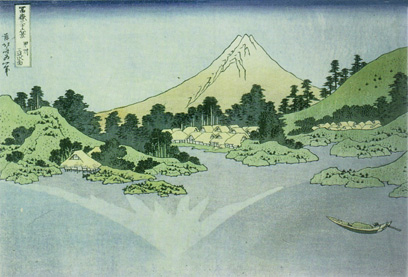
17 "Koshu Misaka Suimen"-Mount Fuji reflected on the Misaka lake waters, Kai Province, depicting green banks through a set of trees and yellow-roofed dwellings.
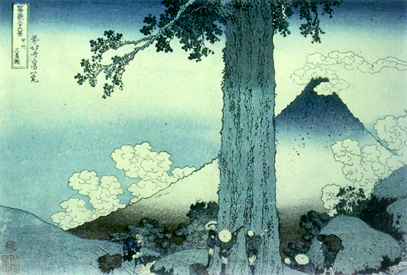
18 "Koshu Mishima-goe"-View taken from Misbima Gorge, Kai Province. At the centre there is a huge tree which three men try to embrace.
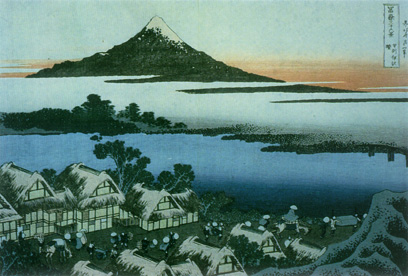
19 "Koshu Izawa no Akatsuki"-Fushi seen from Isawa, Kai Province, in the mist of dawn. A street, some houses and travellers are depicted (bought in 1988).
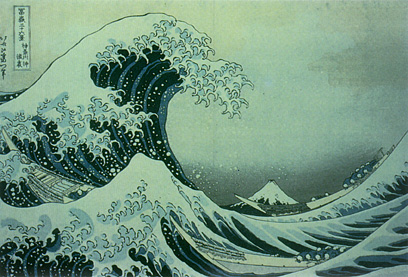
20 "Kanagawa oki namiura"-View of Mount Fuji through high sea waves on Kanagawa coast. This is probably the best known engraving of the set and depicts a huge wave ready to decend on some fishing boats.
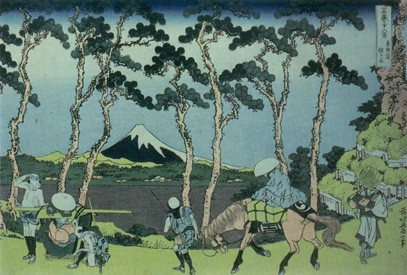
21 "Tokaido Hodogaya"-Mount Fuji depicted with its hill and one of its slopes covered with snow seen from pine trees along the Hodogaya road.
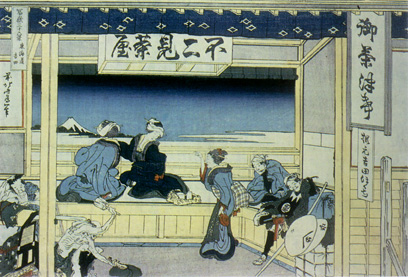
22 "Tokaido Yoshida"-Mount Fuji seen from a tea house (or post office) in Yoshida.
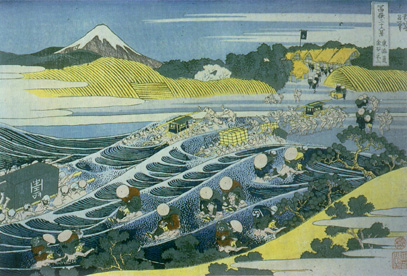
23 "Tokaido Kanaya no Fuji"-View from the furthest bank of Oi river, depicting coolies carrying passengers on their backs and other men carrying goods.
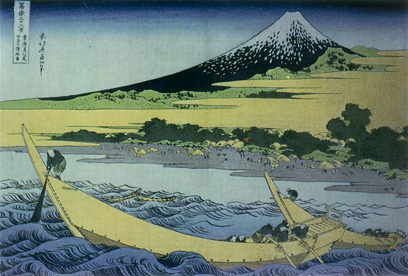
24 "Tokaido Ejiri"-View of Mount Fuji near Ejiri with its cone in blue colours, its snow-covered peak and yellow cloud-covered foot: Two large junks are depicted as well.
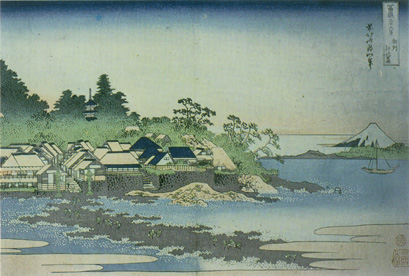
25 "Soshu Enoshima"-View from Enoshima island, Sagami Province, depicting a group of pilgrims going toward Benten temple.
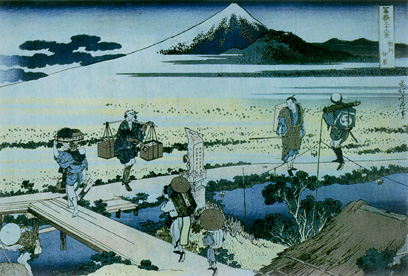
26 "Soshu Nakahara"-View from Nakahara. Soshu Province. Coolies cross a wooden bridge while a fisherman throws his net (bought in 1988).
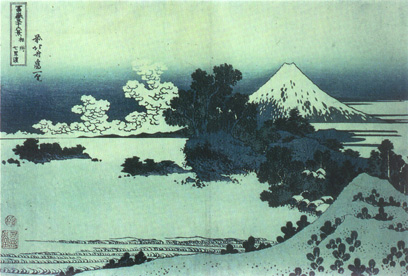
27 "Soshu Shichiri-ga-hama"-View from Shichiri-ga-hama, Soshu Province, depicted with dunes.
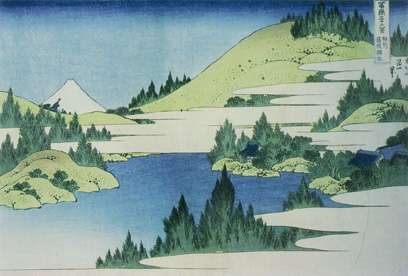
28 "Soshu Hakone no Kosui"-View from the Hakone side, Sagame Province. Some green hills appear from the mist and the lake surface with the white Mount Fuji peak in the background.
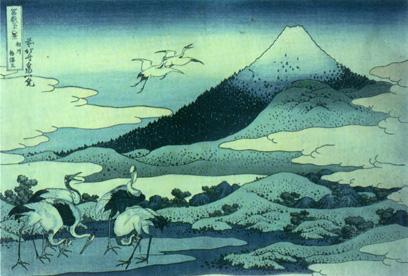
29 "Soshu Umezawa no hidari"-View of Mount Fuji from Umezawa, Sagami Province. A strange set of mountains, woods and clouds depicting herons while two fly toward the Mountain.
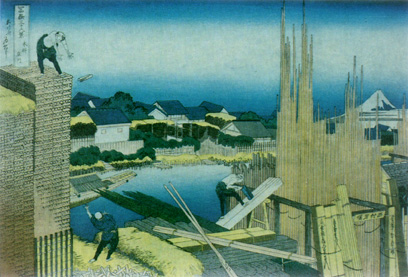
30 "Honjo Tatekawa"-Mount Fuji seen from a wood-sawing mill in Honjo, Yedo, with men sawing and others stacking wooden baulks.
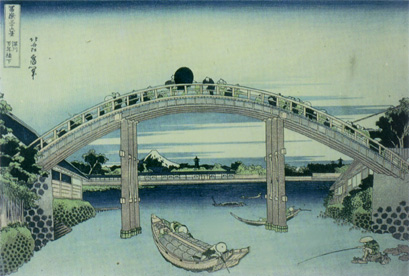
31 "Fukagawa Mannen-beshi shita"-Mount Fuji depicted under a wooden bridge arch over Sumeida river, in Fukagawa.
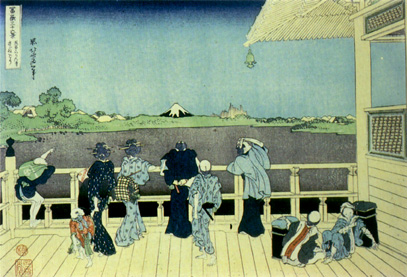
32 "Go-hyaku Rakan-ji Sazaido"-Mount Fuji seen from a large pagoda in Yedo. People watch the view from a belvedere next to the temple.
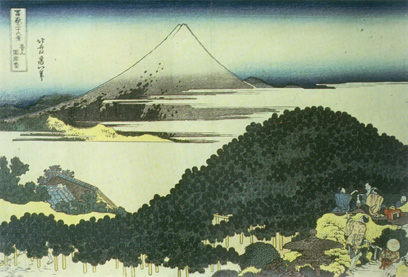
33 "Aoyama enza no matsu"-Mount Fuji seen over the leaves of old pine trees in Aoyama.
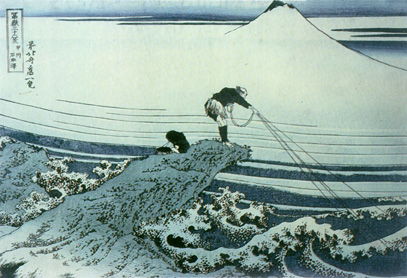
34 "Koshu kajikazawa"-View from Mount Fuji arising over the kerb, depicting a fisherman who picks up a net from a rock.
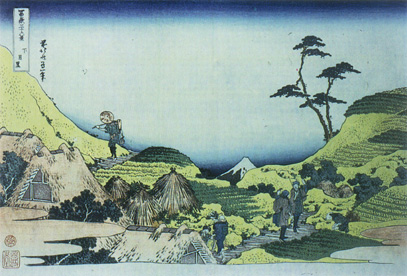
35 "Shimo Meguro"-Mount Fuji seen indistinctly from Seju, Yedo suburbs, depicting three people, two of whom are fishing and the third is riding a horse.
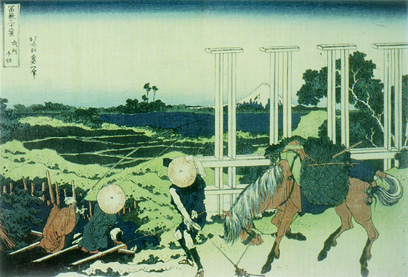
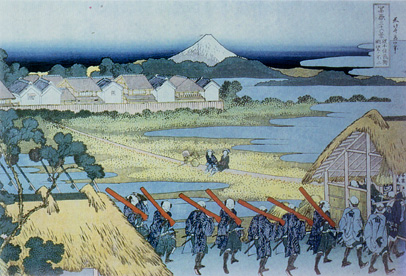
37 "Senju Kagai yori chobo no Fuji"-Another view of Mount Fuji from Senju, depicting two ladies watching a procession going by.
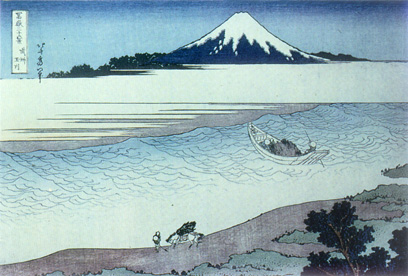
38 "Buyo Tsukudajima"-Mount Fuji seen from Tsukuda-jima, a town at estuary of Sumida river.
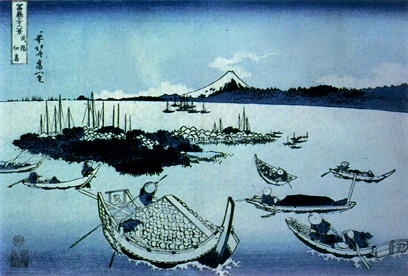
39 "Bushu Tamagawa"-View over Tama river, Musashi Province, depicting a thick mist scene right below the snow covered peak.
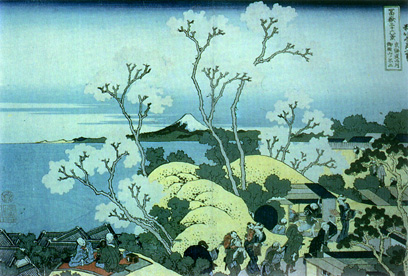
40 "Tokaido Shinagawa Gotenyama no Fuji"-View from far away, in Gotenyama, Tokaido. Depicted are some blooming cherry trees.
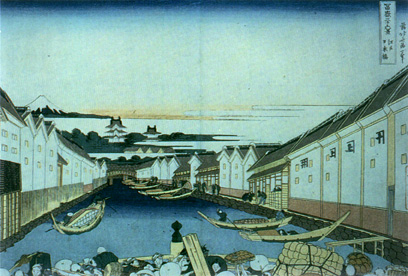
41 "Edo Nihoubashi"-Mount Fuji depicted from over the roof of warehouses, on the bank of a canal. The Uyeno temple towers are seen in the midst and through some trees.
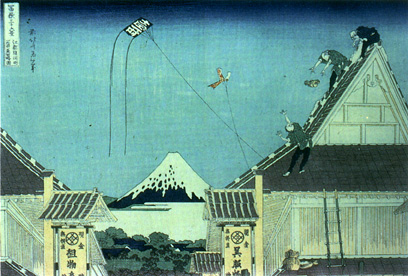
42 "Edo Surugacho Mitsui Mise Ryakuzu"-View of Mount Fuji as seen from Saruga street in the middle of roofs, one of them under repair and depicting some kites.
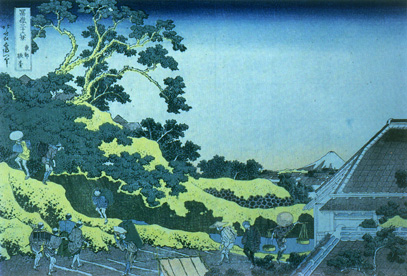
43 "Toto Sundai"-Mount Fuji seen over the Surugadai roofs, a hill in the centre of Yedo.
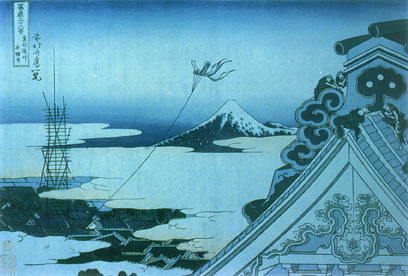
44 "Toto Asakusa Hougauji"-View from Buddhist temple of Hong-Wau-ji, in Asakasa, Yedo; depicted are clouds over roofs and kites flying in the wind.
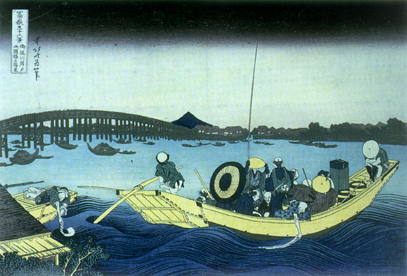
45 "Onmagayashi Yori Ryogoku-bashi Yuhi o miru"-Mount Fuji at sunset over the Ryogoku bridge, Yedo Province, depicting a large boat.
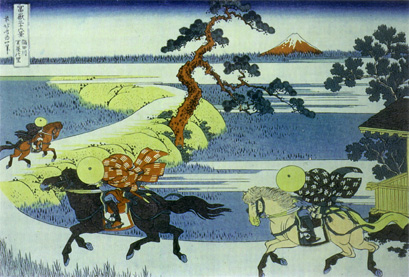
46 "Sumidagawa Sekiya no Sato"-View of a far away Mount Fuji, reddened by the sun setting, seen from Seki-ya village, Sumida river.
* President of the Administrative Council of the Pension Fund of Macau.
start p. 102
end p.